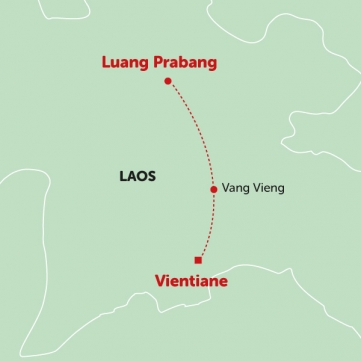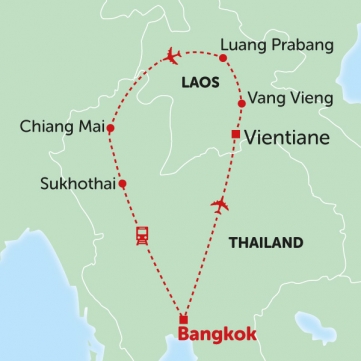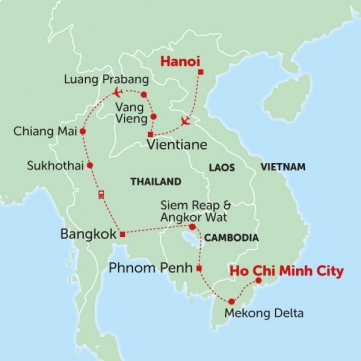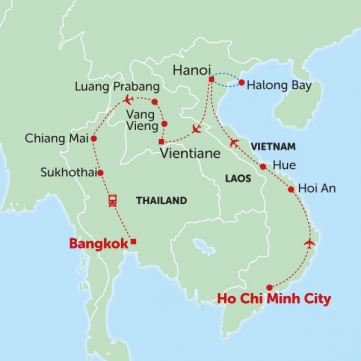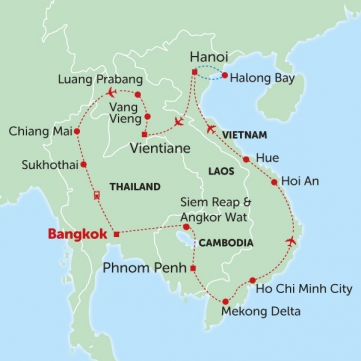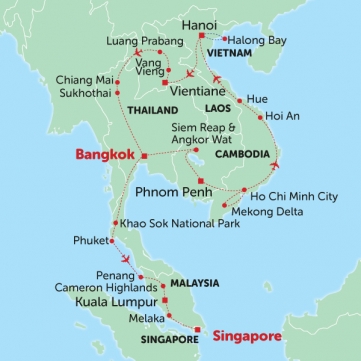Book NOW for $1 £1 €1 • Flexible Payments • No Change Fees • Private Departures Available
- Home >>
- Destinations >>
- Asia >>
- Laos
Laos Tours
Our adventurous tours of Laos take you to the capital, Vientiane, a city so quiet that in 1970, there was only one set of traffic lights in the entire city! Maybe hire a bicycle and explore the local streets and markets. North from Vientiane, you’ll enjoy stunning scenery on the way to Vang Vieng, a peaceful town situated on a plateau with stunning surroundings of limestone caves and waterfalls. On our Laos tours, you will enjoy a glimpse into the Hmong and Yao tribes, which inhabit the area.
The local limestone caves are also visited on our Laos Tours and these caves are renowned in ancient mythology. Vang Vieng is an excellent place to try the local cuisine. After a delicious traditional meal on one of our tours of Laos, you might feel energised enough to hire a bike and cycle to see the limestone karst formations. Luang Prabang refers to the holy Pra Bang, Laos' most sacred image of the Buddha given to Fa Ngoum and this town is renowned for a fascinating history and some of the friendliest people in South East Asia. Located 300 metres above sea level on the upper Mekong River, the town is dominated by Phousi - the marvellous mountain that sits at its heart. So take one of our exciting tours of Laos and you'll discover Lao, French and Lao-French colonial influence as you admire the city's buildings and architectural highlights – all of which you can see on foot.
All Tours of Laos
6 Tours
Laos Travel Articles, Inspiration & Information
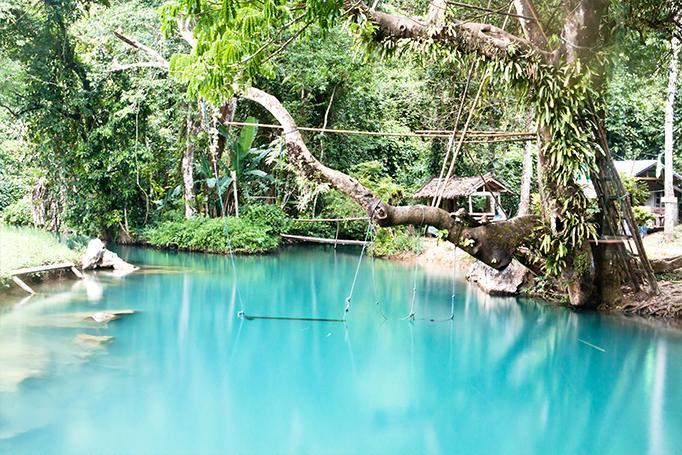
Cycling to the Blue Lagoon
I am always up for a fun day out with the group once we arrive in Vang Vieng so I suggested an optional bike tour out to the famous Blue Lagoon. I had an awesome team, so once we got into town, we tossed our bags down and after a quick briefing on the sights in the town, we got sorted out on the bikes. Read more
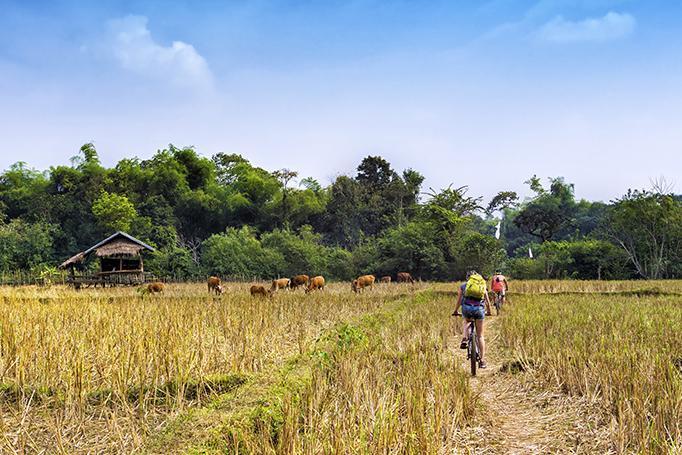
A Fabu-Laos Time
The reality of traveling is that we all try to visit the country that most intrigues us. And sometimes those triggers can stem from seeing that country on a travel show, on a movie or my personal worse, when your friend comes back from it and demands that you sit through the mandatory 2-hr slideshow. You’ll never forget that country’s name.. Read more
Independently Verified Travel Reviews From Past Clients
Laos Travel Guide
Laos Travel Guide
Landlocked and often overlooked, Laos can offer travellers a less frenetic Southeast Asia experience compared to its more popular neighbours, Thailand, Vietnam and Cambodia. Travel in Laos involves shifting down a few of gears, accepting a slower, more languid pace of life and taking the time to appreciate Laos' greatest asset; it's chilled-out, friendly people. Its years of cultural isolation has ensured many traditions live on and its authentic and charming character is one of the biggest draws. Other attractions include its natural landscape which folds and creases in dramatic ridges and river valleys, often drapped in vibrant foliage. There are caves to explore, jungles to trek and mountains to scale making it a popular adventure destination. Culturally, Laos is surprisingly diverse, from the vibrant garb of the northern hill tribes, to the Buddhist wats and temples of the lowlands and the lingering French colonial influence.
Money
Laos's currency is the kip (symbol: ₭ or LAK) which breaks down to 100 att, although you will not see any money in such small denominations and there are no coins in circulation. Notes come in 500, 1000, 2000, 5000, 10,000, 20,000, 50,000 and 100,000 kip denominations. While technically it is against the law to pay in foreign currency, many tourist services will accept Thai baht or US dollars, particularly if it is for a large amount as paying large amounts in kip can be cumbersome.
ATMs are increasingly common in major towns and cities, but can be unreliable, so it is best to carry a mixture of cards (Visa or Mastercard are most accepted) and cash in USD and baht. It is important in Laos, not to rely on cards as your sole means of payment. Travellers cheques are another way to securely carry your travel funds and should be accepted at most banks throughout the country. The maximum withdrawal from a Laos ATM is generally between one and two million kip.
As one of the world's poorest nations, Laos is an inexpensive country for travellers. Food is cheap, particularly if you are eating at street stalls and cheap local restaurants. A budget dinner costs in the vicinity of 20,000-50,000 kip (US$2.50-7.00), a bottle of water around 5,000 kip (60c) and a large bottle of beer laos is usually between 10,000-20,000 kip (US$1.25-$2.50). Entry fees for museums and short excursions tend to be between 10,000 and 30,000 kip.
Bargaining is part of the culture in Laos, and it is approached with a relaxed and fair mindset where both vendor and buyer come to a mutually happy arrangement. Generally speaking sellers in all but the most touristy areas will start with a fairly realistic price and will only expect to come down a little bit. Aggresive haggling over small amounts is not considered appropriate and if you quote a price that is too low the vendor may lose interest.
Major Cities and Towns in Laos
Curled around the banks of the Mekong River near the Thai border, the Laos' capital of Vientiene does not have the energy of some of Southeast Asia's other capital cities but is a nice place to enjoy a drink overlooking the Mekong River. It is also home to the national museum and nearby Xieng Khuan Buddha park with its bizzare collection of statues. To the north, Vang Vieng is an outdoorsy town set amoungst towering limestone outcrops and verdant rice paddies where you can go rock climbing, caving, river tubing or hiking. Next up the road is Luang Prabang is perhaps Laos' most alluring destination, with elegant temples, wats and French shopfronts laden with faded opulence of times gone by. The nearby Kuang Si waterfalls are breathtaking and make a popular day trip from the city. Further afield, the northern towns of Phongsali, Luang Namtha and Udomxai are potential starting points to explore the remote north with its hiking opportunites and ethnic minority villages. In the south, Savannaket offers preserved French-colonial architecture. Nearing the Cambodian border, Pakse has nearby Angor-style ruins and Si Phan Don, the idyllic four thousand islands river archipelago.
Electricity
The electricity supply in Laos runs at 220 volts AC. The most common outlets are two pin sockets taking flat or round prong plugs. It is recommended to pack a universal adaptor to cover your bases. The Laos power supply can be erratic and may be switched off at night in smaller towns, so be aware of surges to protect your devices and pack a torch if heading to remote villages.
Etiquette and Culture
Laos is a diverse nation and has, at times, been estimated to have up to 149 ethinic groups. They are simplified into three main groups, based on what altitude they are found – the Lao Loum (lowland Lao), Lao Theung (Lao of the mountain slopes) and Lao Soung (Lao of the mountain tops). The Lao Tai is the fourth group which is often combined into the Lao Loum and, although they are closely related, they have resisted adapting to mainstream culture and many still live according to their traditional tribal ways. Over half of the population is Lao Loum and their language is the national language.
Around 60% of the population follow Theravada Buddhism, including most of the lowland Lao. The other predominant religious influence is spirit worship called Phii worship or animism which, although it is official banned, coexists harmoniously alongside Buddhism. It is particularly strong amoungst tribal Lao. Other religions present in Laos include a small number of Christians, Muslims and Cham.
It is important to dress conservatively in Laos, which means covering shoulders and thighs for women and men should not go shirtless. In keeping with Buddhist traditions, feet are considered unclean and you should not step over anyone and if you accidentally kick someone immediately apologise and smile. A person's head is considered sacred and should not be touched, even for children. Shoes are generally removed before entered a home or temple and if sitting, feet should always point away from any religious image or statue.
Laos is famously laid back and friendly and visitors will find they will receive a more welcome reception if they smile a lot and greet locals with sabai di (hello). Strong emotions are tabboo and if you show anger, don't be surprised if locals respond with amusement or simply walk away.
Geography
Laos has an area roughly the size of Great Britain and is a landlocked nation bordering with Myanmar, Thailand, Cambodia, Vietnam and China. Mountains and plateaus cover almost three quarters of the land making the scenery dramatic with river valleys and mountain passes. The northern half of the country is characterised by jagged mountain ranges. The Annamite Chain, which runs down half the length of the country, includes the Khammuan Plateau with its limestone grottoes and steep gorges.
The Mekong River runs parallel along the length of the country, marking part of the border with Thailand before flowing into Cambodia. It is navigable in places but the waterfalls and rocky islands around Si Phan Don mean it cannot be practically used for transport between Laos and Cambodia. The Mekong floodplains through the central part of the Laos portion of the river is where most of Laos' rice is cultivated and makes up the most tropical part of the country.
History
The first extensive Lao kingdom was formed by Fa Ngum in the mid-14th century, an Angkor-educated Lao prince who was given an army from the Khmer with which to gain control of the middle-Mekong and stave off the threat from the Thai kingdom of Sukhothai. He founded the kingdom of Lan Xang with his capital at Xiang Dong Xiang Thong (later renamed Luang Prabang). This kingdom persisted until the early 18th century although it suffered setbacks from invasions and succession disputes.
After a devastating, though ultimately unsuccessful invasion by the Vietnamese, the kingdom recovered under the rule of King Visoun who came into power in 1501. He was succeeded by his son and then his grandson Setthathirat who moved the capital from Xiang Dong Xiang Thong to Viang Chan (later renamed Vientiane by the French) in response to the threat of invasion from Burma. Setthathirat was Laos' greatest builder, constructing Wat Xieng Thong, the most beautiful surviving Buddhist temple in Laos, as well as several monasteries in Luang Prabang, a new palace in Viang Chan, That Luang stupa and a number of royal temples.
The kingdom endured until the death of King Suriya Vongsa whose son was put to death for adultery leaving the line of succession uncertain. This led to the rulers of Luang Prabang and later Champasak in the south to declare independence, fragmenting Laos into several weaker kingdoms that were obvious targets for the Siamese. This led to Siam (Thai) lordship over Laos, with all kings requiring prior approval before being crowned and regular tributes to be paid.
The French had gained control of neighbouring Cambodia by 1863 and eventually won Laos from Thailand in 1893 when a French warship travelled up the Chao Phraya River to Bangkok, forcing the Thais to sign over all territory east of the Mekong River. Administrative control was returned to Vientiane and the French brought in Vietnamese civil servants and French officials to enforce colonial control.
The catalyst for change in the area was World War II where the Japanese ruled Laos for just six months before the end of the war. The Lao Issara (free Laos) group formed an interim government and declared independence but infighting and foreign interference caused continued unrest with control of the country returning to the French until full independence was granted in 1953.
The Vietnam War led the North Vietnamese and the Americans to use Laos to gain strategic advantage, although according to an international agreement signed in Geneva in 1962 Laos was a neutral state and the presence of foreign military in the country was forbidden. This neutrality was flouted by both sides with the North Vietnamese using Lao territory to move troops and supplies into South Vietnam and the Americans training the local Hmong people as their 'secret army' and launching an air war over Laos. During the war they dropped an estimated 2 million tons of bombs on Laos over the course of 9 years at a cost of 7.2 billion US dollars.
The communist group Pathet Lao (land of the Lao) took control of the country after the war ended, after a brief, unsuccessful coalition. It suspended the 650-year monarchy declaring Lao a democratic republic. The government restricted free speech and assembly and nationalised the economy which led to inflation and price controls. During this time it's believed that up to 10% of the population, particularly the educated classes, left the country. Some others were sent to remote re-education camps. To aid recovery, it was decided to open the economy to market forces and allow foreign aid and investment to enter the country from the West.
Best time to travel in Laos
Seasons
Laos has a tropical climate, experiencing a seasonal monsoon. There is also variation in the climate between the north and the south given the country's length and elevation of the northern highlands. Weatherwise the best time to travel is between November and April during the dry season when humidity is at its lowest. It can also be very busy at this time of year, so it's best to book your travel well in advance. It can also be cold in the mountains.
The hottest part of the year begins in April and May and continues until October with Laos experiencing higher rainfall and humidity. September and October can be particularly wet with heavy, short tropical downpours occurring, generally in the afternoon.
When to travel
In addition to weather considerations, there are several key events that happen throughout the year in the Lao calendar. Lao New Year (Bun Pi Mai) happens in April and celebrations include processions in Luang Prabang. You may also be doused by locals carrying buckets and water guns as this time of year is marked by an almost countrywide water fight!
Bun Bang Fai is the rocket festival and falls in May. Locals fire big rockets into the air to call the rain down for the planting season ahead. It's all out revelry with crowds and parties.
The festival of lights, Lai Heua Fai, is held in October and is a magical, fairy-like show of lanterns, lights and floats being put down the river. It is a ritual paying homage to the river and to send away sickness and bad luck. The most spectacular celebrations happen in Luang Prabang.
Guide to food in Laos
Lao cuisine is similar to food found in northern Thailand. One of the most important ingredients in Lao cooking is nâm pa, a fish sauce made from fermented fish. In addition to this key ingredient, other flavours include chillies, lemongrass, coriander, lime juice, tamarind, coconut milk and ginger. Lao food is a balance of heat, fragrant herbs and a touch of sourness.
A staple food in Laos is sticky rice and it is served with most meals, often in a woven basket. It is eaten with the right hand, rolled into balls and dipped into food. Plain white rice and noodles are also served alongside main dishes.
Laos' most famous dish is larp or laab, a salad made from thinly sliced meat or fish, dressed in a marinade of lime juice, fish sauce, coriander, mint, chilli and spring onions. It is often served with vegetables such as lettuce and is traditionally served raw, although you are more likely to be served the cooked version.
Papaya salad is another popular dish, called tam mak hoong, made with shredded green papaya, garlic, chillies, lime juice and peanuts.
Noodle soup, called fõe, is another popular dish often eaten for breakfast. It gets its name from the Vietnamese dish pho and is made with a light fragrant broth served with sliced meat, rice noodles and fresh chopped herbs.
The French left a lingering legacy on the country's taste buds with baguettes still sold on the street and coffee grown in southern Laos. There are also some upmarket French restaurants in Vientiane and Luang Prabang.
Desserts don't feature greatly in Lao cuisine, but there is a wealth of fresh tropical fruit owing to the country's warm climate including mangoes, pineapple, bananas and watermelon.
The local brew is Beer Lao and it is considered one of the best beers in South-east Asia.
Top Attractions and Highlights in Laos
1. Luang Prabang
An ancient royal city with golden temples alongside crumbling French architecture, it's no wonder Luang Prabang is now Laos' leading tourist destination. With saffron-robed monks and foliage-draped river banks is it one of the most picturesque spots in the country.
2. Vientiane
The capital city and largest city in Laos, Viantiene still retains its relaxed and friendly atmosphere give it a distinctly small-town feel. There are temples to explore and museums to visit, and once you're done you can put your feet up and relax next to the Mekong River and get into the Lao pace of life.
3. Vang Vieng
A laidback town set amongst jungle-clad cliffs and emerald rice paddies. Previously notorious for the dangerous river tubing conducted by backpackers on the nearby river, Vang Vieng is now a popular outdoor destination where caving, climbing, kayaking and trekking.
4. Tham Kong Lo Caves
Journey into the underworld, through this vast limestone cave system in the Phu Hin Bun National Park. Considered by many to be Laos' top natural attraction these caves are a geographical wonder and you feel as though you have discovered another world as your guide takes you deeper into the earth by longtail boat.
5. Si Phan Don (4000 islands)
A riverine archipelago on the Mekong River near the Cambodian border, you can stay on the islands here and truly get away from it all. The area has south-east Asia's largest waterfall, as well as rare flora and fauna including the elusive freshwater dolphin.
6. Savannakhet
Savannakhet is a western Lao town offering perhaps the best preserved French-colonial architecture in the country. This sleepy, tight-knit community gives a charming insight into traditional life and nearby trekking opportunities allow exploration into the surrounding forest, lakes and tribal villages.
7. Champasak and the Wat Phu ruins
These Angkor-like ruins in southern Laos are one of the country's archaeological treasures and far less visited than their Cambodian counterpart. Apart from being a UNESCO World Heritage Site the ruins actually predate many similar sites in Cambodia and Thailand.
8. Phonsavan and the Plain of Jars
Phonsavan is a provincial capital in northern Laos, best known by travellers for being the point from which you can explore the mysterious Plain of Jars, a collection of sites containing thousands of large stone vessels which experts believe to be ancient funerary jars.
9. Kuang Si Falls
Close to Luang Prabang is the spectacular Kuang Si Falls, a three-tier waterfall consisting of shallow pools of water in which you can go swimming, surrounding by the rainforest. It's one of Laos' most beautiful natural phenomenons.
10. Luang Namtha and northern hill tribe trekking
Perched on the banks of the Nam Tha River in northern Laos, Luang Namtha is a relaxed and sleepy place best for arranging an expedition to trek to northern hill tribe villages and witness some of Laos' colourful and diverse ethnic minorities.
10 Interesting Facts about Laos
1. Laos' original name is Lan Xang meaning 'land of a million elephants'.
2. The various ethnicities that make up the country's population are divided into four groups based upon the altitude where they live – Lao Loum (lowland Lao), Lao Tai (upland valleys and central), Lao Theung (Lao of the mountain slopes) and Lao Soung (Lao of the mountain tops).
3. The Khone Phapheng Falls in Laos are the largest in South-east Asia and are the main reason why the Mekong River is not fully navigable.
4. The US dropped over two million tons of bombs on Laos during the Vietnam War, making Laos the most bombed country per capita in the world. Many of the bombs did not explode leaving Laos with a legacy of unexploded ordnance (UXO) making it dangerous to walk off established paths in some parts of the country.
5. Laos has a population of just under 7 million, making it one of the least densely populated countries in Asia.
6. Laos has never won an Olympic medal.
7. The mysterious plain of jars in central Laos is believed to be over 2000 years old and very little is known about the civilisation that created the jars. It is believed they were used as vessels to place the dead before eventual cremation. There are between 1900 and 2500 jars and jar fragments so far discovered in the area.
8. The Lao New Year is called Bun Pi Mai and falls on 14-16 April. It is the most important holiday of the year when houses are cleaned, new clothes are worn and Buddha statues are washed. The Lao people may douse one another in water and there can be street processions with elephants and traditional costumes.
9. The Lao language is a tonal language written in script consisting of 30 consonant symbols and 28 vowel and vowel combination symbols.
10. Laos is a single party, socialist state.



